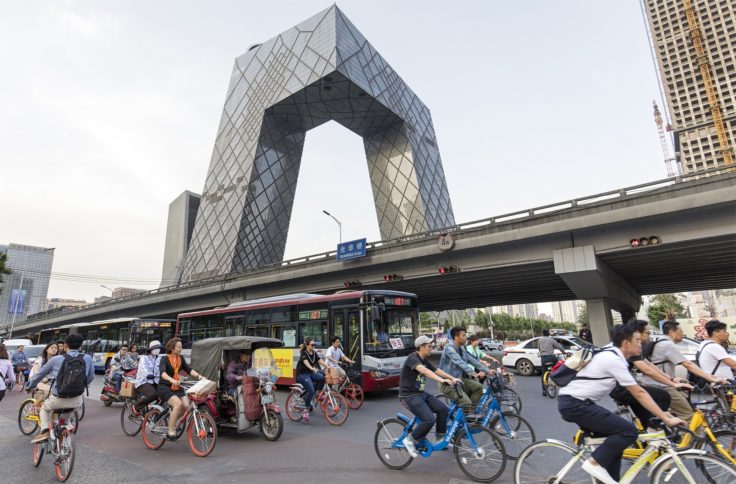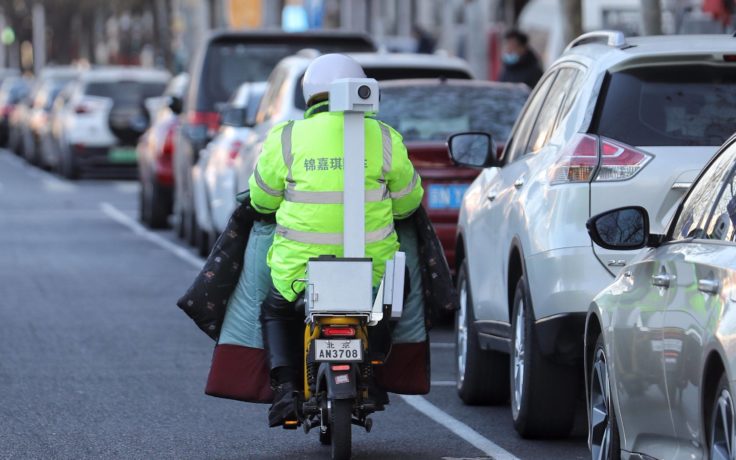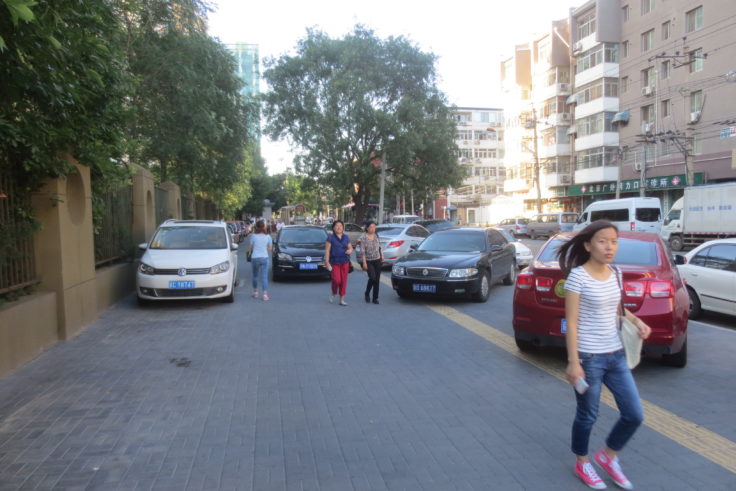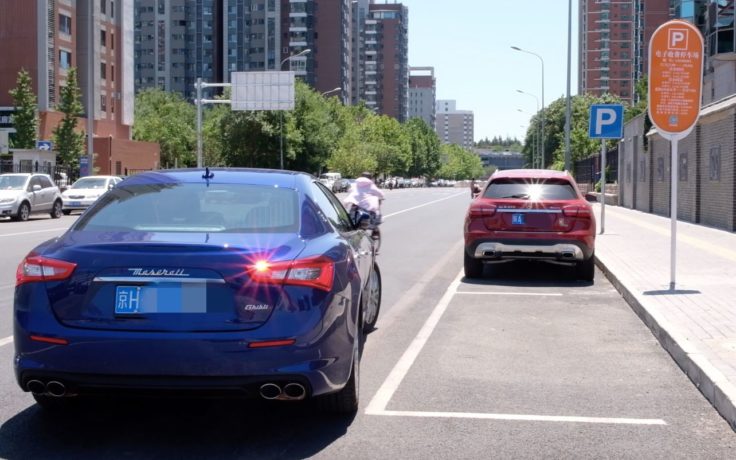January 21, 2023
How Beijing is Rethinking Parking and Reclaiming Public Space
By Liu Shaokun and Bram van Oojin, ITDP China
Due to rapid motorization and a lack of parking management policy, Beijing’s sidewalks, setbacks, bicycle lanes, and streets have been gradually taken over by illegal, unsafe parking in recent years. As a result, people have often been seen dodging cars on sidewalks or being forced to walk in traffic. Cyclists have had their lanes blocked by parked cars, causing them to swerve dangerously into mixed traffic. Some private entities have been running illegal parking operations — utilizing public street space and pocketing the profits — while, at the same time, off-street parking lots that charge higher fees have been beset by low occupancy rates.

Since 2014, ITDP China has worked with Beijing to develop much-needed parking reforms for the city of over 21 million.
Due to this stark imbalance in the supply and demand for parking space across the city, pedestrians and cyclists have often been the ones paying the heftiest price in safety, accessibility, and health. Beginning in 2014, ITDP China and its partners, with the support of the Beijing Municipal Commission of Transport, have collaborated to propose parking reforms for Beijing which will help the city shape new, forward-thinking strategies. Over the last few years, to combat the volatile, informal parking systems that have arisen, the department eliminated free on-street parking, implemented on-street parking management systems, and incentivized drivers to use vacant off-street parking spaces. While many of these steady shifts in parking policies are still underway, they present a key window of opportunity to reshape mobility and accessibility for over 21 million residents.
Reclaiming Streets from Parking
In 2019, the city started the operation of 84,000 paid on-street parking spaces on over 900 roads across central Beijing. On streets that were not managed previously, parking occurred haphazardly and blocked thoroughfares for pedestrians and cyclists. Now, parking spaces are demarcated on the streets and illegal parking on sidewalks is made impossible through the use of bollards and other physical measures.
To increase acceptance of these interventions amongst Beijing’s drivers, and to ease operation of the system, drivers pay for parking on their phones using a Beijing Transportation app, which now has over 6 million registered users. Electronic payments have also allowed the city government to receive
data on who parks where and for how long, which is crucial in helping the city optimize the system and help with oversight.

Combating Illegal Parking
Beginning in 2015, Beijing also ramped up its enforcement of illegal parking, with over 2 million tickets issued in the first half of 2016. The sidewalks of 150 streets, intersections, and driveways were also lined with bollards to prevent and discourage drivers from parking illegally. Pedestrians and cyclists in the central districts of Beijing are now able to enjoy sidewalks and bicycle lanes free from the haphazard parking of the past.
Since 2019, with the implementation of a new tech-forward on-street parking system, parking management has been automated. On-street parking spaces are managed through intelligent parking cameras that document parked vehicles and dispatches parking wardens in case of non-payment. Besides static parking cameras, parking wardens on 48 streets also use bicycles equipped with cameras that document license plates of vehicles for payment verification. This is critical to ensuring that cars do not continue to park illegally or idle while obstructing pedestrian and cycling traffic.

As of 2020, nearly 28,000 parking spaces across 330 off-street parking lots in Beijing are shared, which reduces the need for new parking construction.
Reforming Off-Street Parking
Like many cities around the world, Beijing used to require real estate developers to build large amounts of parking for residential and commercial developments, regardless of factors like car ownership, proximity to transit, and market demand. These minimum parking standards incentivized more driving, more congestion, and reduced the amount of public space available for housing, recreation, and transit. With much of Beijing’s existing parking supply sitting empty and the expansion of a 25-line metro network, the city recognized the need to act on this issue by publishing updated standards in 2021 for all new real estate developments.
This included the overturning of “parking minimums” and the implementation of “parking maximums” for all non-residential off-street parking lot developments within central Beijing, where most commercial and office zones are located. A parking minimum is still in place for the remaining parts of Beijing, but is now also paired with a maximum, requiring real estate developers to not add an excessive amount of new parking supply. The new parking standards will greatly reduce parking availability for many commuters, and is expected to result in a significant shift to more sustainable modes of transit in the long term. Beijing is the first Chinese city to implement reductions on parking supply on such a large scale, and could prove to be a model for the rest of the country.
To improve the efficiency of existing parking spaces and reduce the need for additional off-street parking facilities, Beijing has also been active in promoting the use of “shared parking” approaches. As of 2020, nearly 28,000 parking spaces across 330 off-street parking lots in Beijing are shared, where residents can park in commercial lots at night and reduce the need for new off-street parking construction in residential areas.

Looking Ahead
Beijing has the highest motorization rate of all Chinese cities, with over 6.8 million registered vehicles in 2021. Beginning as far back as 2011, in order to alleviate traffic congestion and air pollution, Beijing implemented car ownership restrictions with limited issuance of new plates and invested heavily in mass transit by increasing the number of metro lines. In the same period, the number of bus routes increased by 48%, and the city almost tripled its bus-only lanes. Cycling and walking trips have also increased over the past decade, spurred by investments in cycling networks and the arrival of dockless bikeshare systems.
While there is still much progress to be made for this major city, Beijing has taken important steps in managing its parking challenges and in reclaiming public space from disruptive, illegal parking. Sidewalks and cycle lanes in the central areas have been made safer and more accessible for walking and cycling. Leveraging technology to restrict on-street parking can encourage people to choose alternative modes of transport altogether. Parking maximums and sharing policies have also helped reduce the growth of excessive off-street parking developments.
The city now faces the challenge of expanding its new parking policies and interventions across all areas of the city, and further tightening off-street parking maximums and the overall management of new systems. The impact of these parking strategies still warrant evaluation, but Beijing’s steady progress over the past decade demonstrates that transformation is possible for cities all across China.
